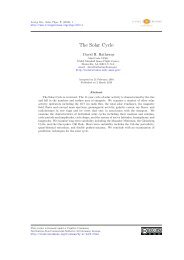PDF (for b&w printout) - Living Reviews in Solar Physics
PDF (for b&w printout) - Living Reviews in Solar Physics
PDF (for b&w printout) - Living Reviews in Solar Physics
Create successful ePaper yourself
Turn your PDF publications into a flip-book with our unique Google optimized e-Paper software.
The Sun <strong>in</strong> Time: Activity and Environment 17<br />
Further Doppler maps have been presented <strong>for</strong> the early G-type ultra-fast rotators He 520 (P =<br />
0.49 d) and He 699 (P = 0.61 d). Aga<strong>in</strong>, apart from the prom<strong>in</strong>ent polar spots, there is a def<strong>in</strong>itive<br />
band of low-latitude (l ∼ < 30 – 40 deg) spots on these stars as well (Barnes et al., 1998).<br />
Although these surface spot distributions vary significantly between young solar analogs, there<br />
is agreement with regard to high-latitude magnetic activity on all of them (Rice and Strassmeier,<br />
2001; Strassmeier et al., 2003).<br />
The most recent Doppler technique uses spectropolarimetric observations of l<strong>in</strong>es to apply<br />
Zeeman–Doppler Imag<strong>in</strong>g (ZDI), which results <strong>in</strong> maps of radial, azimuthal, and meridional magnetic<br />
fields. Successful application to solar analog stars have been presented by Marsden et al.<br />
(2006) and Catala et al. (2007); excellent ZDI maps have also been derived <strong>for</strong> the somewhat<br />
cooler, young early-K star AB Dor (Donati et al., 2003b), and put <strong>in</strong>to context with coronal Xrays<br />
(Jard<strong>in</strong>e et al., 2002c; McIvor et al., 2003; Hussa<strong>in</strong> et al., 2007). ZDI images (Figure 2) have<br />
shown non-solar magnetic features such as high-latitude “r<strong>in</strong>gs” of azimuthal (toroidal) field (Donati<br />
et al., 2003b; Marsden et al., 2006; Catala et al., 2007), possibly suggest<strong>in</strong>g that the responsible<br />
magnetic dynamo is located close to the surface (a “distributed dynamo”) rather than (only) near<br />
the tachocl<strong>in</strong>e where azimuthal fields are expected <strong>for</strong> αΩ-type dynamos. The field distribution<br />
and orientation also serves as an important diagnostic to study and expla<strong>in</strong> spot lifetimes based<br />
on numerical studies (I¸sık et al., 2007).<br />
Figure 2: Zeeman–Doppler images of the rapidly rotat<strong>in</strong>g early G dwarf HD 171488, show<strong>in</strong>g, <strong>in</strong><br />
polar projection, spot occupancy (upper left), the radial magnetic field (upper right), the azimuthal<br />
magnetic field (lower left – note the r<strong>in</strong>g-like high-latitude feature), and the meridional magnetic<br />
field (lower right) (from Marsden et al. 2006, repr<strong>in</strong>ted with permission of Blackwell Publish<strong>in</strong>g).<br />
<strong>Liv<strong>in</strong>g</strong> <strong>Reviews</strong> <strong>in</strong> <strong>Solar</strong> <strong>Physics</strong><br />
http://www.liv<strong>in</strong>greviews.org/lrsp-2007-3



